The Sciatica Guide: Causes, Treatment and Solutions

Low back and leg pain usually get diagnosed with
Sciatica in 1 of 2 ways
1) Go to a doctor, and receive the diagnosis of sciatica
2) Consulting Dr. Google searching for “causes of leg pain” and Sciatica #1
So naturally, you must have sciatica.
But you’re properly wondering:
“What is Sciatica really, and how do I how do I get my sciatic nerve to stop hurting?”
Hint: It’s NOT WHAT YOU THINK (2021 Update)
Most believe that sciatica is a tight hamstring issue l and thus will be cured by stretching. Tight hamstrings don’t cause sciatica, and stretching make sciatica worse.
Sciatica Meaning?
These terms can be confusing, but they mean the same thing for practical purposes. Sciatica, by definition, means a painful, inflamed sciatic nerve. When the sciatic nerve pain starts, it’s referred to as sciatica.
Radiculopathy of the sciatic nerve implies that the sciatic nerve is being compressed by a structure such as a herniated disc, thus creating sciatic nerve damage. This compression creates sciatic nerve pain, creates sensations down the back of the leg.
“Pain down the back of the leg below the knee is the signature sign of sciatica.”
Anatomy of Sciatic Nerve
The sciatic nerve is the largest in diameter peripheral nerve (outside the spine) in the body. It originates from the nerves of the lower back. (L4-5) travels under the buttocks (gluteus maximus) and down the leg to the knee.
Usually, at this point (behind the knee), it divides into two branches into the peroneal and tibial nerve that travels to the foot.
Therefore, technically sciatica can be anywhere between the buttocks and the foot! So explains sciatica that makes you walk with a limp.
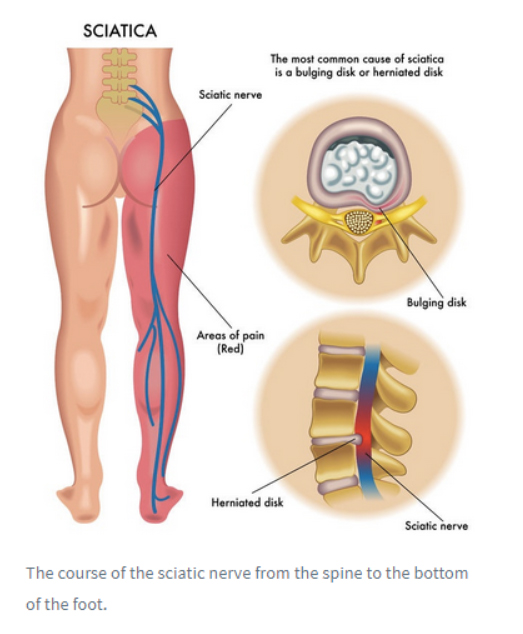
6 Major Causes of Sciatica
1) Intervertebral Foreamen Compression (IVF)- “The pinched nerve.”


We are going to compare a pinched nerves pressure to that of a garden hose.
You ever pinched a garden hose so you could super soak your brother or sister from a greater distance?
Well:
That occurs because you effectively increased the pressure, but the overall volume of water dramatically decreased. The same thing happens with blood flood (that supplies the nerve) at this IVF opening for the nerves.
Don’t believe me?
Try filling up a bucket with a pinched hose vs. a free hose and see which one fills up faster.
That’s a simple way to explain what’s occurring at this IVF.
Essentially a passageway for the nerves of the low back exit begins their descent down the back of the leg.
A pinched L5 nerve in the low back from a disc herniation can create a compression “pinched nerve” and give you sciatica and walking problems. This hole is the most common location of compression (pinched nerves) and irritation of nerves of the lower back (lumbago)
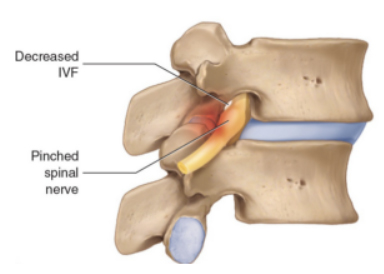
A pinched L5 nerve in the low back from a disc herniation this whole can create a compression “pinched nerve” and give you sciatica and walking problems. The intervertebral foramen is the most common location of compression (pinched nerves) and irritation of nerves of the lower back.
Common reasons for pinched nerves at the intervertebral foremen
- Herniated Disc, Slipped disc, bulging disc
- Arthritis- Bone deformation decrease the overall size of the IVF.
- Inflammation
- Fluid dynamics- “Blood flow congestion aka pinched hose analogy.”
- The poorly controlled movement that stresses the nerve
Scientific studies have shown us that this hole in the spine increases and decreases it’s dimensions with various movement patterns. Therefore some movements increase the size and others decrease the size of the IVF. So repetitious movement in a closing direction (smaller hole) is a logical mechanism of pain generation for sciatica.
2) Excessive Sitting
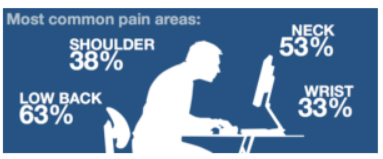
Sitting is known to cause many painful areas of the body including low back pain and sciatica.
Sitting is known to cause many painful areas of the body, including low back pain and sciatica.
One of the most common complaints of patients with sciatica is that leg pain is worse with long periods of sitting. This pain could be as soon as a person is seated with severe cases. Minor cases can take a few hours to creep up.
Scientific studies have shown us that the IVF in the spine increases and decreases its dimensions with various movement patterns. Sitting puts strain on the sciatic nerve.
Experiencing sciatica while sitting is generally due to strain on the low back. Thus creating referral down the back of the leg into the sciatic nerve.
Remember that hole called the intervertebral foremen?
3) Improper lifting Mechanics
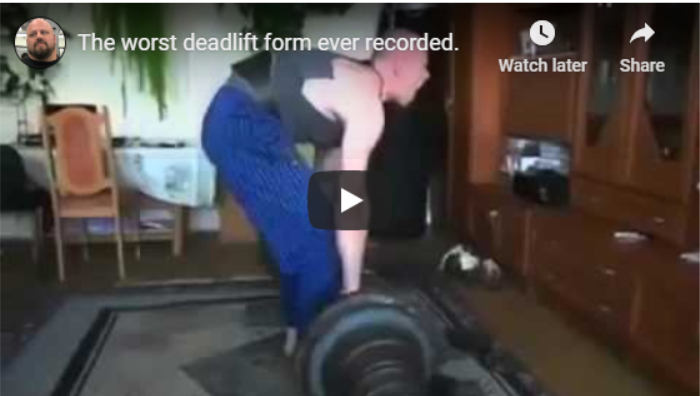
The majority of cases of sciatica and leg pain are referral from the low back. Therefore lifting mechanics becomes a vital aspect of both creating and eliminating sciatic nerve pain.
“The common myth is that you “should lift with your knees.” In reality, you should be lifting with your hips.” These sayings refer to which joints are bending the most during deadlifts.
Lifting with a low back rounded rather than the motion primarily coming from the hips increases stress on the spine. Over time, it can create sciatica. A world-leading expert in spinal biomechanics (Stuart McGill) shows that lifting with a forward flexed position can injure the lumbar disc after many repetitions. This injury is commonly known as a herniated disc.
This herniated disc created then can decrease space in the IVF mentioned in #1 and develop sciatica regardless of the low back hurts at the time.
4) Poor Control of the Pelvis
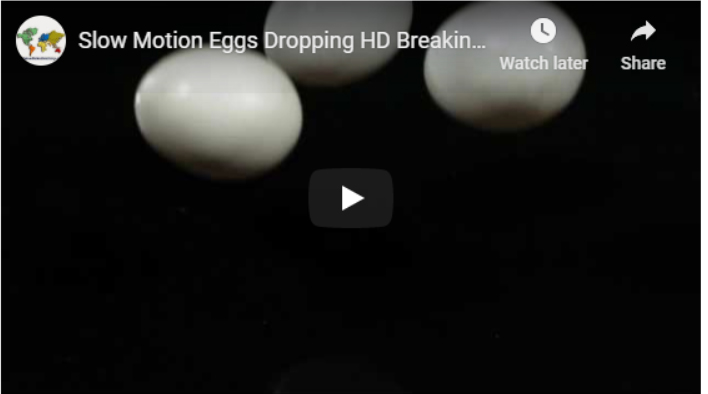
Walking and running require that a person can control the pelvis. Therefore managing impact forces of the foot interacting with the ground is crucial!
The Egg Drop Analogy.
If you throw an egg up in the air and catch it with a stiff hand?
What Happens?
It Breaks.
If you throw an egg up into the air and disperse the energy over a more extensive range of motion (as you catch it), then it doesn’t break.
Crazy, I know.

The patient has leg pain after running and first thing in the morning.
The picture on left is showing pelvic drops that can occur during walking and running.
This occurs due to a poorly controlled pelvis.
Remember that hole in the spine where nerves can become pinched.?
Well:
When the pelvis drop occurs there is an increase in strain on the joints and nerves of the low back. Similar to stepping off a curb when you didn’t expect it. It Hurts!
This is one of the most common reasons that I see for sciatica in runners.
This runner was complaining about sciatica after running.
5) Deep Fascia and Muscle Tightness

Example of how the healthy deep fascia is essential for standard glide and slide of the muscles.
Have you ever wore a tight pair of pants that limited your ability to move?
What happens?
You lift your leg, the pants bunch up, and then move from the spine to accomplish the task.
Very similar to what occurs when your muscles and fascia are tight.
The muscles are incased by connective tissue that encases the muscle group, like putting a sock on foot.
That sock decreases friction and allows you to slide on your shoe with more ease.
Well:
Fascia surrounds muscles decrease the friction of muscle groups allowing good gliding and sliding next to each other. Thus pivotal to ensure normal biomechanics. When gliding and sliding hinder movement in the low back or hips, it can increase pressure on the sciatic nerve.
6) Decreased Flexibility of the Sciatic Nerve.
Myth Buster
It’s a common belief with both patients and some doctors that nerves don’t stretch.
Wrong:
Nerves consist of highly elastic (stretchy) connective tissue. They need to stretch during normal human movement by walking, running, and even doing the splits.
Research has found that nerves can stretch up to 22% before failure. That’s increasing their length by 1/5!
If the sciatic nerve becomes tight, then it can become sensitive, creating sciatic nerve symptoms.
So all you need to do is stretch your hamstrings.
WRONG!
The sciatic nerve and the hamstrings need to stretch entirely differently.
“Stretching your hamstrings will make sciatica worse, not better.”
How Do I Treat my Sciatica at Home?
I know it must be killing you by now.
How do I Stretch the Sciatic Nerve?
We need to understand some fundamentals about nerves personalities (neurodynamics) stretch them. I’ll keep this simple. Nerves hate sustained tension (stretch), compression, and these factors deprive the nerve of oxygen.
They love being in a position of rest, being slacked, and receiving lots of oxygen.
My “go-to favorite” home remedy for sciatica is the standing leg swing Nerve Stretch.
Step by Step Instructions
- Hold on to something with the opposite arm of the sciatic nerve you’ll stretch.
- Kick the painful leg forward until you feel a very light STRETCH in the hamstring, back, or even calf. There should be NO PAIN if this is a very short distance, then that’s completely ok!
- Do 15 repetitions.
- Take a complete 60 seconds break.
- Do this 3-5 times a day if the pain isn’t made worse. If so, consult a medical professional. (recommended regardless)
The standing leg swing is a safe way to stretch the sciatic nerve by giving it what it loves rather than what it hates.

Take micro-breaks as a method to relieve low back pain and sciatica.
Sitting is the New Smoking: Take micro-breaks to Relief Sciatica and Low Back Pain.
Back in the ’90s, it was popular in the corporate wellness world to have professionals come and give long ergonomic advice workshops.
Unfortunately, the only ergonomic position that can relieve your low back pain and sciatica is the position that you frequently break.
The 45:1 rule
Stand up and move for one minute every 45 minutes you’ve seated.

Creating a New Habit- Hip Hinging
Since most sciatica is a referral from the low back, we need to move in such a way that doesn’t put unnecessary stress on the low back.
To put this simply, move from your hips rather than the spine.
The Kiss the Wall with your Butt Exercise
- Stand with feet just a few inches from the wall.
- Then bend forwards with your body so that only your butt touches the wall.
- Move your feet a few inches forward
- Continue this until you are far enough away from the wall that you can sit in a chair.
Standing Like a Boss- How to Stand Without Sciatica
Sciatica and low back pain while getting out of a chair are common reasons patients seek my help. Usually, this patient will press their hands on the knees as a point of perceived stability to push themselves into an upright position. This puts the low back in a position of strain due to most of the upper body weight being in front of the body’s centerline.
Exercises to Avoid While Experiencing Sciatica
During acute sciatica, many exercises will worsen the symptoms in the long run, even if these exercises make your leg pain feel better for ten minutes. Then that nagging leg pain returns with a vengeance.
Sound Familiar?
Patient bending forward to stretch low back and hamstrings (creating pain in one leg)

Patient bending forward to stretch low back and hamstrings (creating pain in one leg)
Top Exercises to avoid when you have acute sciatica. (most cases, not all)
- Forward fold from Yoga (See left)
- Sustained stretching of the hamstring and low back (See above)
- Burpees
These are not the only exercises to avoid while the sciatic nerve is actively generating pain.
This guide discusses sciatic nerve anatomy, what causes sciatic nerve pain, sciatica symptoms, what causes sciatica to flare up, and how to relieve leg pain from sciatica. This article is for educational purposes only and doesn’t replace a proper examination from a chiropractor, physical therapist, or medical professional.
GET IN TOUCH WITH DR. DEAN
YOU should be able to move the way you’d like to move without experiencing pain. YOU should be able to experience freedom and energy knowing there’s nothing holding back from giving your life 110%. Dr. Dean would like to learn more about your challenges with a quick phone or email before beginning treatment. Contact him today.
